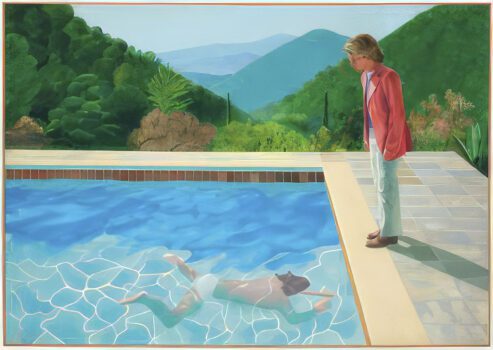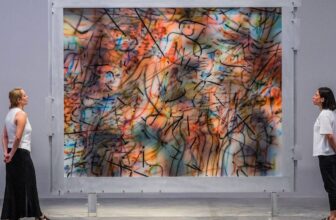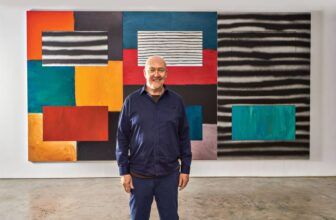Meaning of David Hockney’s Pool with Two Figures
The water ripples with the kind of light that only California seems able to produce. A man swims underwater, his body refracted by the sunlight, while another, standing in a pale pink jacket, looks down at him from the pool’s edge. The moment feels intimate yet mysterious, still yet in motion, quiet yet brimming with tension.
This is David Hockney’s Portrait of an Artist (Pool with Two Figures), painted in 1972. On first glance, it’s deceptively simple: a bright pool, two figures, and the idyllic backdrop of the Los Angeles hills. But like most works that seem straightforward, it conceals layers, emotional, personal, and art-historical, that tell a far more complex story.
The Genesis of a Masterpiece
David Hockney, born in Bradford, England, in 1937, had already been a star of the British Pop Art scene by the time he moved to California in the mid-1960s. The vibrant West Coast lifestyle, its pools, sun, and relaxed sensuality, captivated him. Swimming pools became a recurring motif in his work, not just for their visual beauty but for their metaphoric resonance.
The idea for Portrait of an Artist (Pool with Two Figures) began, as Hockney himself recalls, by pure chance. While flipping through photographs in his studio, he came across two images: one of a figure swimming underwater, and another of a man looking downward. Side by side, they sparked something. What if, he wondered, these two unrelated figures were placed together in one scene? Could their juxtaposition create a visual story, one that was ambiguous but emotionally charged?
It was a simple concept with enormous possibilities.
The First Attempt, and Failure
Hockney’s first attempt to merge the images onto a single canvas was, in his own words, “a disaster.” The composition felt forced, the colors wrong, the figures lifeless. In frustration, he abandoned the project entirely. Months passed. But the idea wouldn’t leave him.
In 1972, just weeks before a scheduled exhibition in New York, Hockney decided to try again. This time, he worked with an almost obsessive dedication, painting for 18 hours a day over a two-week period. The second attempt was the painting we know today, an image that would go on to become one of the most famous of the 20th century.
A Love Lost
To understand the painting’s emotional depth, we need to look at Hockney’s life in 1972. He had recently gone through a painful breakup with Peter Schlesinger, a young American artist and former lover. Schlesinger had been a muse and frequent subject in Hockney’s work, appearing in many of his portraits and drawings.
In Portrait of an Artist (Pool with Two Figures), the man standing poolside is widely believed to be Schlesinger. The swimmer, whose face is obscured by water, remains anonymous, a ghostly presence, unreachable, existing in another element entirely. Many art historians interpret the painting as a meditation on separation: one man looking down at another, close in physical space but isolated by circumstance, emotion, and perhaps memory.
That ambiguity, the possibility that this is both a moment of observation and of farewell, is part of the painting’s enduring allure.
The Meaning, What Is This Painting Saying?
While Hockney himself has avoided giving a single “official” interpretation, the painting’s meaning can be explored on several levels:
1. Emotional Distance
The positioning of the figures creates a dynamic of separation. The standing man, fully clothed, is in the realm of air and light. The swimmer, immersed in water, is in another world entirely. They are together in the same frame yet divided by an invisible barrier, an apt metaphor for emotional disconnection.
2. The Fluidity of Perception
Water distorts shapes, colors, and clarity. The swimmer is visible but not fully knowable. This could be read as a reflection on how we perceive others: through a refracted lens of memory, desire, or longing.
3. The Contradiction of Stillness and Motion
Hockney loved the challenge of painting water because it allowed him to capture movement in a medium, oil on canvas, that is inherently still. Here, the glass-like stillness of the standing figure contrasts with the shimmering movement of the swimmer, creating visual tension.
4. California Dreaming, and Its Shadows
In the 1960s and ’70s, California represented freedom, youth, and beauty. But Hockney’s painting reminds us that even in paradise, human emotions are complicated. The sunlit pool is a stage for a quiet, perhaps bittersweet, human drama.
Why Did Hockney Paint It?
The practical answer is that he was drawn to the composition sparked by those two photographs. But the deeper answer lies in the confluence of personal experience and artistic ambition.
Hockney had always been fascinated by dualities, love and loss, presence and absence, reality and perception. The breakup with Schlesinger gave these ideas new urgency. By revisiting the two-figure composition, he could explore the emotional impact of being near someone yet feeling profoundly distant.
And perhaps, like all great artists, Hockney was also painting to understand himself. The canvas became a space where he could reconcile, at least visually, two worlds: the vivid, sun-drenched surfaces of life and the turbulent, submerged feelings beneath them.
Type of Art, Where Does It Fit?
Portrait of an Artist (Pool with Two Figures) belongs to the Pop Art movement in the broadest sense, though Hockney’s style often defies strict categorization.
Key Features of Its Style:
Figurative Realism: The figures are recognizably human, rendered with clarity, though without photographic hyper-detail.
Flat Planes of Color: The background hills, the pool tiles, and the clothing are painted in smooth, unmodulated tones, a hallmark of Hockney’s style.
Photographic Influence: The composition originated from photographs, a method Hockney often used to experiment with perspective and arrangement.
Bright, Non-Naturalistic Colors: The palette captures the heightened reality of California sunlight rather than a literal reproduction.
It’s a fusion of Pop Art’s boldness, modern realism’s observational precision, and Hockney’s unique fascination with space, light, and intimacy.
The Price of an Icon
Over the decades, Portrait of an Artist (Pool with Two Figures) became one of Hockney’s most recognized and reproduced images. But in 2018, it made headlines worldwide when it sold at Christie’s in New York for $90.3 million, at the time, the highest price ever paid for a work by a living artist.
This was more than just an art market milestone. It was a recognition of Hockney’s place in the canon of modern art, cementing him as one of the most significant painters of his generation.
Where Is the Painting Now?
The work is currently held in a private collection, meaning it’s not permanently on public display. However, it has been loaned to major exhibitions, such as retrospectives of Hockney’s work at Tate Britain in London, the Centre Pompidou in Paris, and the Metropolitan Museum of Art in New York.
Its absence from a single, permanent museum home only adds to its aura. When it does appear, it becomes an event, a rare chance to stand before one of modern art’s most enigmatic images.
Technical Brilliance, A Closer Look
Standing before the actual painting, one is struck by its scale, over 7 feet wide and 10 feet tall. The large size immerses the viewer, making the pool feel like a space you could almost step into.
The Water
Hockney had long been fascinated by the problem of depicting water, especially the way sunlight dances across its surface. He developed his own vocabulary of wavy lines, ripples, and geometric patterns to suggest transparency and movement. In Portrait of an Artist, the water becomes a character in itself, mediating between the two human figures.
The Figures
The swimmer’s anonymity contrasts with the standing man’s sharp features and tailored clothing. This draws our attention to the psychological distance between them.
The Light
California sunlight is notoriously difficult to paint without washing out color. Hockney uses flat, vibrant hues to keep the brightness intense but controlled.
The Cultural Legacy
Since its creation, the painting has appeared in books, documentaries, and countless art history lectures. It’s been interpreted as a gay love story, a commentary on perception, an ode to California living, and even as a subtle critique of modern alienation.
The truth is that its meaning shifts with the viewer. That’s its genius: it offers just enough narrative to engage the imagination while withholding a definitive story.
Hockney’s Own Words
In interviews, Hockney often resists over-explaining his work. About Portrait of an Artist, he once remarked:
“I never like to explain too much. The joy of painting is that it can mean different things to different people.”
That openness is part of why the painting continues to feel alive, decades after it was made.
A Poolside Mystery That Endures
Half a century after its creation, Portrait of an Artist (Pool with Two Figures) still holds viewers in its spell. It is at once personal and universal, sunny and melancholy, simple and endlessly interpretable.
Hockney transformed a chance juxtaposition of photographs into a timeless meditation on human connection, or its absence. And in doing so, he gave the world a painting that, like the ripples in its water, keeps moving in the mind long after you’ve looked away.
Quick Facts Recap:
Title: Portrait of an Artist (Pool with Two Figures)
Artist: David Hockney
Year: 1972
Style: Pop Art / Modern Realism
Dimensions: Approx. 7’ x 10’
Meaning: Often read as a meditation on emotional distance, perception, and memory; inspired by a personal breakup.
Auction Price: $90.3 million (2018)
Current Location: Private collection; exhibited internationally on loan. image/ wikipedia




